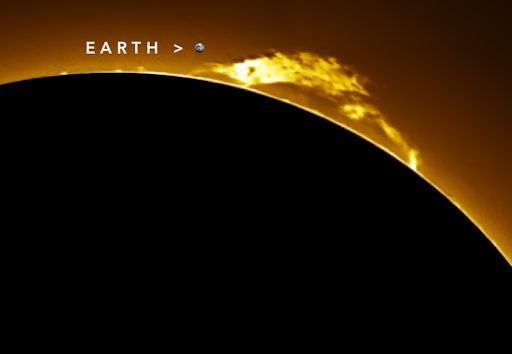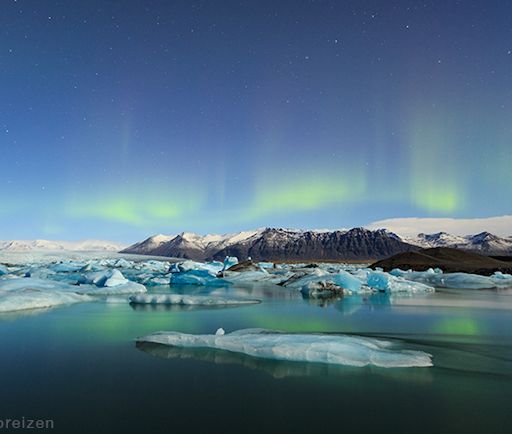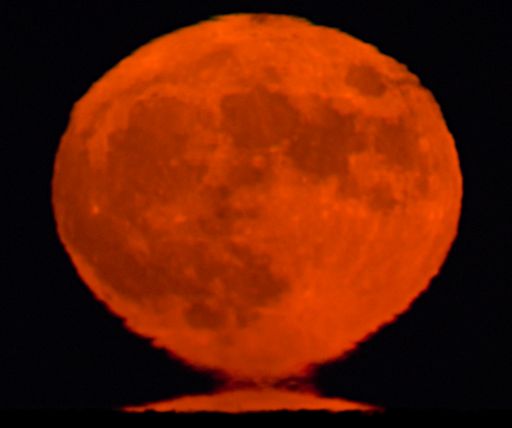Marianne's Heaven On Earth Aurora Chaser Tours Chasethelighttours.co.uk invites you to join them in their quest to find and photograph the Aurora Borealis. Experience the winter wonderland in the Tromsø Area. | | | THE SUN IS FLATLINING: With no sunspots actively flaring, the sun's X-ray output has flatlined. The quiet is likely to continue for at least another 24 hours. NOAA forecasters say there is no more than a 1% chance of M- or X-class solar flares on Nov. 28th. Solar flare alerts: text or voice SOLAR PROMINENCE, POISED TO ERUPT? The face of the sun may be quiet, but the edge of the sun is not. A gigantic arch of plasma is dancing along the sun's southwestern limb. Shahrin Ahmad of Sri Damansara, Malaysia, photographed the structure on Nov. 28th: 
Ahmad inserted a picture of Earth for scale. The plasma-filed prominence stretches more than 150,000 km from end to end--dimensions that make it an easy target for backyard solar telescopes. Monitoring is encouraged. Magnetic fields holding the plasma aloft are twisted, tangled, and prone to explosive magnetic reconnection. An eruption could occur at any moment. Solar flare alerts: text or voice Realtime Space Weather Photo Gallery MOONLIT AURORAS: For the past few nights, auroras have been difficult to see through the glare of the full Frosty Moon. On Nov. 27th, a splash of green penetrated the moonlight over Iceland: 
"The moon lit the icebergs on lake Jökulsárlón in Iceland and made it almost look like daytime," reports photographer Madelon Dielen. "The auroras were there for a few minutes--just enough to give some extra color to this beautiful scene. " The green could intensify in the nights ahead. NOAA forecasters estimate a 45% chance of G1-class geomagnetic storms by Dec. 1st when a high-speed stream of solar wind is expected to hit Earth's magnetic field. Aurora alerts: text or voice Realtime Aurora Photo Gallery THE MOLTEN FROSTY MOON: According to folklore, this week's full Moon is the "Frosty Moon," named after the ground frosts of northern autumn, which sparkle so beautifully in full moonlight. When John Stetson of Cape Elizabeth, Maine, watched the moonrise on Nov. 25th, however, the Frosty Moon appeared to be melting: 
"Earth's atmosphere, acting as a lens, bent the light on the horizon to create this effect," explains Stetson. "It is called an Etruscan Vase moonrise." This phenomenon is most often seen when the Moon is rising over a body of water. Stetson was watching from the shore of Casco Bay. The lower Moon (the base of the Etruscan Vase) is an inverted image of the upper Moon produced by refraction in a layer of warmer and less dense air close to the water's surface. "The temperature of water in the Bay was 51 degrees," says Stetson. "This created a layer of relatively warm air just above the water's surface. The ambient air temperature was much lower, only 41 degrees." In short, conditions were perfect for the mirage. Browse the realtime photo gallery for more images of the Frosty Moon--molten and otherwise. Realtime Space Weather Photo Gallery
Realtime Comet Photo Gallery
Realtime Noctilucent Cloud Photo Gallery
Realtime Meteor Photo Gallery Every night, a network of NASA all-sky cameras scans the skies above the United States for meteoritic fireballs. Automated software maintained by NASA's Meteoroid Environment Office calculates their orbits, velocity, penetration depth in Earth's atmosphere and many other characteristics. Daily results are presented here on Spaceweather.com. On Nov. 28, 2015, the network reported 13 fireballs.
(13 sporadics)  In this diagram of the inner solar system, all of the fireball orbits intersect at a single point--Earth. The orbits are color-coded by velocity, from slow (red) to fast (blue). [Larger image] [movies] Potentially Hazardous Asteroids ( PHAs) are space rocks larger than approximately 100m that can come closer to Earth than 0.05 AU. None of the known PHAs is on a collision course with our planet, although astronomers are finding new ones all the time. On November 28, 2015 there were potentially hazardous asteroids. Notes: LD means "Lunar Distance." 1 LD = 384,401 km, the distance between Earth and the Moon. 1 LD also equals 0.00256 AU. MAG is the visual magnitude of the asteroid on the date of closest approach. | | Cosmic Rays in the Atmosphere | | Situation Report -- Oct. 30, 2015 | Stratospheric Radiation (+37o N) | | Cosmic ray levels are elevated (+6.1% above the Space Age median). The trend is flat. Cosmic ray levels have increased +0% in the past month. | | Sept. 06: 4.14 uSv/hr (414 uRad/hr) | | Sept. 12: 4.09 uSv/hr (409 uRad/hr) | | Sept. 23: 4.12 uSv/hr (412 uRad/hr) | | Sept. 25: 4.16 uSv/hr (416 uRad/hr) | | Sept. 27: 4.13 uSv/hr (413 uRad/hr) | | Oct. 11: 4.02 uSv/hr (402 uRad/hr) | | Oct. 22: 4.11 uSv/hr (411 uRad/hr) | These measurements are based on regular space weather balloon flights: learn more. Approximately once a week, Spaceweather.com and the students of Earth to Sky Calculus fly "space weather balloons" to the stratosphere over California. These balloons are equipped with radiation sensors that detect cosmic rays, a surprisingly "down to Earth" form of space weather. Cosmic rays can seed clouds, trigger lightning, and penetrate commercial airplanes. Our measurements show that someone flying back and forth across the continental USA, just once, can absorb as much ionizing radiation as 2 to 5 dental X-rays. Here is the data from our latest flight, Oct. 22nd: 
Radiation levels peak at the entrance to the stratosphere in a broad region called the "Pfotzer Maximum." This peak is named after physicist George Pfotzer who discovered it using balloons and Geiger tubes in the 1930s. Radiation levels there are more than 80x sea level. Note that the bottom of the Pfotzer Maximim is near 55,000 ft. This means that some high-flying aircraft are not far from the zone of maximum radiation. Indeed, according to the Oct 22th measurements, a plane flying at 45,000 feet is exposed to 2.79 uSv/hr. At that rate, a passenger would absorb about one dental X-ray's worth of radiation in about 5 hours. The radiation sensors onboard our helium balloons detect X-rays and gamma-rays in the energy range 10 keV to 20 MeV. These energies span the range of medical X-ray machines and airport security scanners. | | The official U.S. government space weather bureau | | | The first place to look for information about sundogs, pillars, rainbows and related phenomena. | | | Researchers call it a "Hubble for the sun." SDO is the most advanced solar observatory ever. | | | 3D views of the sun from NASA's Solar and Terrestrial Relations Observatory | | | Realtime and archival images of the Sun from SOHO. | | | from the NOAA Space Environment Center | | | the underlying science of space weather | | | a sponsor of SpaceWeather.com | | 
